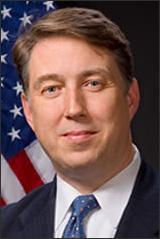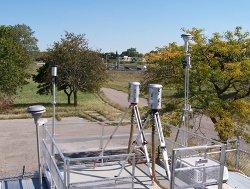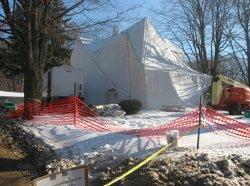EPA Science Matters Newsletter: Volume 2, Number 1
Published January / February 2011
Executive Message
- Executive Message: The Next 40 Years: Sustainability
Sustainability and Innovation at EPA

As we embark on 2011, I am particularly excited about the new directions and new beginnings taking shape in our agency. Here at EPA, we have a strong tradition of excellence in science—one that we are well poised to build upon to take environmental protection to the next level. For decades, we have protected human health and the environment by reducing air pollutants and water contaminants, cleaning up hazards waste sites, and many other significant actions. In 2011 and beyond, we have the opportunity to strengthen this legacy through actions that Administrator Jackson has described in terms of both innovation and sustainability.
Our research focus in 2011 will continue to emphasize high priority areas including toxic chemicals, air toxics and water treatment technologies. But in addition to the cutting edge knowledge that we have traditionally pursued, we will continue to drive toward innovative and sustainable solutions. What does this mean for EPA research?
- It means that by investing in research on innovative technologies, we can promote synergies between environmental protection, health protection and the pursuits of economic growth and job production.
- It means that instead of working to make things less bad, we are working toward a healthy, sustainable environment. As Administrator Jackson put it recently, “It’s the difference between treating disease, and pursuing wellness…”
- It means that we are approaching our research with a holistic, systems perspective rather than chemical by chemical, problem by problem, reductionist approach.
This re-shaping of our approaches, methods, and mentality is a response to a call to action made by Administrator Jackson when she launched a new National Academy of Sciences (NAS) study in November. In real time, the NAS is convening the leading scientific experts in the nation to build upon 25 years of sustainability science and provide an operational framework for sustainability that can be incorporated into the work of EPA.
In her announcement of the study, which is being called the Green Book, Administrator Jackson explained, “…what I am announcing today is not an initiative, program or project. It is the beginning of a new approach. It is a step toward the more effective pursuit of all of our work, including our statutory requirements, by incorporating sustainability into our foundations.”
As an agency, we are ready to face scientific challenges in 2011 that range from mountain top mining to hydraulic fracturing to endocrine disruption and more. But the reason it’s so important to invest in the kind of new thinking, methods, and approaches that Administrator Jackson has called for, is to ensure our ability to take on those challenges we can’t foresee. Innovative thinking and sustainable approaches will be out best tools to confront new environmental challenges as they arise.
Sincerely,
Paul T. Anastas
Assistant Administrator
U.S. EPA
Office of Research and Development
GEMS: Great Environmental Moments in Science
- Can Highways Contribute to Asthma?
EPA scientists and partners team up to examine the link between road-related air pollution and susceptibility to asthma.

Can living near a highway make you more susceptible to asthma attacks? EPA scientists, together with partners from the University of Michigan, are examining this question through the Near Roadways Exposure to Urban Air Pollutants Study (“NEXUS” for short).
“Over the last 15 years, there's been a lot of public concern about the impact of roadways on community health,” said Dan Costa, National Program Director for EPA’s Clean Air Research Program. “So we’re trying to learn how exposure to traffic can worsen asthma in kids.”
Over the next year, study scientists will be conducting a comprehensive asthma trigger study, using data from more than 60 children living in Detroit who suffer from asthma. Study scientists will look at the mixture of pollutants that originate from Detroit-area highway traffic and how the pollution affects children with asthma. Data collected from air near major highways, as well as in homes and schools will shed more light on the mixture of air pollutants that affect asthma and overall health.
While there is a demonstrable link between roadway pollution and decreased respiratory function, scientists have yet to pinpoint what substances are primarily responsible. Air pollution near roadways can come from several sources: burning fuel, road dust, and tire and break wear, all of which have very different physical and chemical properties.
“We don’t have a really good understanding of which pollutants associated with roadways are especially bad for your health,” explained Alan Vette, an EPA scientist who is working on the current asthma study.
Vette is working with the University of Michigan’s Dr. Stuart Batterman and scientists from across several scientific fields to track air pollution over its entire lifecycle, from identifying its various sources to its ultimate effects on human health.
One of the first steps the scientists are taking is an examination of the composition of air pollution by source. Pollution produced by coal-burning power plants, for instance, has a different specific mix of chemical gases and particles than pollution associated with highways.
Building on lessons learned from past EPA-led research on near roadway air pollution, NEXUS will include studies of air pollutant sources, near-roadway air pollution levels and behaviors, and indoor air quality. During the study, scientists will also compare the toxicity of various air pollutants and conduct an epidemiological analysis of the health effects of air pollution.

“We’re exploring whether pollutants from roadways make viral infections more common and more severe in sensitive populations,” said Dr. Stuart Batterman, who is leading the University of Michigan’s part of the study. Batterman explained that certain types of air pollution may make asthma sufferers more prone to respiratory viruses, which in turn can aggravate asthma symptoms.
Researchers said Detroit, long the heart of the American automotive industry, presents an ideal study site for several reasons. First, the city has a complex air environment that allows scientists to examine a wide variety of pollution sources, levels, and types. In addition to Detroit’s many heavily-travelled highways, researchers will be able to look at pollution from other sources, including coal-fired power plants, metal refineries, and other heavy industries. They’ll also be able to examine the mix of airborne substances (including mold, pet dander, and tobacco smoke) in study participants’ homes and at several schools in order to compare those levels with the measurements taken at outdoor ambient air quality sampling sites.
Air pollutants sometimes behave differently when in the presence of other air pollutants, and scientists working on the NEXUS program will be examining how these interactions take place and their ultimate impact on health.
EPA scientists tout another good reason to conduct a study the Detroit area: Community Action Against Asthma (CAAA) ― a participatory research partnership organized by the University of Michigan. The group includes leaders and members of many of Detroit’s communities and citizen groups and has acted as a partner in the NEXUS project from its inception. Davyda Hammond, an EPA scientist who has worked extensively with CAAA, said the group has helped community members engage with researchers in crafting the project’s design and methods.
“They’ve helped with recruitment, and with home visits,” Hammond said. “A lot of times, the residents will feel more comfortable talking with someone from their community.”
Hammond said the NEXUS project has created job opportunities for Detroit residents, employing community members in data-gathering efforts and participant interviews. She said the training they have received to prepare for this work will prepare them for future work in scientific research.
Furthermore, the families participating in the study are being given access to the data collected from their homes. As researchers gather biological data from the children enrolled in the study, they’re also working with CAAA to help the families gain access to health care when needed, and providing information to help reduce asthma triggers in their homes.
“Because of the strong community involvement, we can help them receive the treatment that they need,” Hammond said.
Next Steps
When NEXUS’ data-collection phase ends next year, scientists plan to look for epidemiological patterns: What pollutants are most strongly associated with asthma?
The data will also help scientists test and improve air quality models. By linking data from the ambient sites with data collected from Detroit homes and schools, scientists will be able to better determine how the ambient air is contributing to residents’ overall exposure to pollutants, and how to better predict health effects caused by air pollution. Knowing which chemicals are the most harmful will allow policymakers to make better-informed decisions about clean air policies in their communities – targeting specific chemicals, for example, makes it easier for industry to comply with new clean air regulations.
“Air pollutants all have their own set of causes and effects,” Costa said. “We have the capabilities within EPA to do the trans-disciplinary research necessary to develop a tool that can help decision makers understand how these are going to affect their communities.”
Learn More
- Can Rain Barrels and Gardens Help Keep Sewage in the Sewers?
EPA researchers investigate how well rain barrels and rain gardens retain stormwater and how to motivate the public to adopt these "green" practices.

If someone offered to plant a garden in your yard, would you allow it? What if they even offered to pay you as an incentive to gain your approval?
This is exactly what EPA researchers in the Mt. Airy region of Cincinnati did to encourage residents of the Shepherd Creek watershed to adopt individual stormwater management practices of rain gardens and rain barrels. Rain barrels catch and store rainwater runoff from roofs, and rain gardens help detain and infiltrate runoff on the ground.
“People were literally chasing down the landscaper trucks saying, ‘Where can I get one of these? My neighbor has one…I want one of those!’” recounts Bill Shuster, an EPA hydrologist involved with the Shepherd Creek project.
The aim of this project is to install numerous rain barrels and rain gardens across the watershed and then to monitor stormwater runoff in the creek for any changes in water volume and quality.
Rain barrels and gardens are considered “green” stormwater management practices and are intended to help reduce stormwater problems.
“Whether it’s storm sewer or septic overflows or flooding in your basement or in your backyard – this is all tied to stormwater,” explains Shuster, “and if we can take simple approaches and be intentional about their implementation, we will find that it’s easy to take care of these problems.”
In typical U.S. communities, most rainwater flows over impervious, man-made surfaces such as house roofs and paved roads instead of more natural areas such as forests or grasslands. The resulting runoff flows through traditional drainage pipes into what is called a combined sewer system.
As a consequence, when large rainstorms dump massive amounts of water, these sewer systems which carry human and industrial waste become susceptible to overflows and backups. Combined sewer overflows cause risks to environmental and human health.
The Shepherd Creek watershed, like many others, has this type of combined sewer overflow problem.
“We wanted to do [the project] in such a place that it could be replicated in other places. It was always our intent to come up with a tool that other places with same problem could adopt, so we chose the Shepherd Creek area,” says EPA scientist Hale Thurston.
In order to raise awareness about green stormwater management and to distribute rain gardens and barrels to individuals in the watershed, researchers conducted two reverse auctions in 2007 and in 2008. A reverse auction is one in which there are many sellers (in this case, the homeowners) and only one buyer (the project team). Over 400 residences were invited to participate in the auctions where they could bid on how much they should be paid in order for rain barrels and gardens to be installed on their property (installation and maintenance were free for home owners).
Unexpectedly, the majority of people who participated in the reverse auction actually bid $0.
“It was a pleasant surprise that people, with just a little bit of knowledge about the problem, were willing to participate even without very much financial incentive to do so,” observes Thurston.
Two hundred bids were received, ranging from a low of paying nothing to a high of $500, and researchers worked with contractors to install nearly 170 rain barrels and 81 rain gardens by mid 2008. In total, 25% of residential properties, distributed throughout the watershed, ended up with one of these “green water management facilities.”
Researchers are currently in their third and final year of collecting data from the Shepherd Creek watershed. They hope to learn if the use of rain barrels and gardens decreases the amount of stormwater flowing into the creek during heavy rains. Rain gardens might also help filter runoff water of pollutants as it soaks into the ground.
One other facet of this study involves closely monitoring 10 rain gardens and 10 rain barrels in the watershed. The results of this research could help quantify how much rain water is actually detained by these technologies.
So far, the most dramatic effects have been found in a neighborhood where a high proportion (about 50%) of homes in one specific drainage area have accepted rain garden and rain barrel installations. Scientists developed predictive models that indicate stormwater outflow from this specific area has decreased by 5%-20% from the use of these green infrastructure practices.
The preliminary results aren’t as dramatic elsewhere. “Although we don’t see effects at the larger, watershed level, this neighborhood (where gardens and barrels were relatively dense) tells us that there is promise and a distinct ability to create detention in this area with a very simple, engaging auction approach,” says Shuster. “We are building citizen storm water managers who are willing and able to take on this environmental management challenge through the use of what are largely passive…and user-friendly management practices.”
Results are inconclusive so far as to rain barrels’ and gardens’ ability to rid water of pollutants, and scientists have observed no change in the creek’s overall water quality. However, at the conclusion of field monitoring in May 2011, researchers will perform a full analysis of the gathered data to better understand what sort of impact these management actions might have.
Studies like this that quantify the benefits of such small-scale technologies have attracted a great deal of interest both domestically and internationally. This research could help pave the way to green stormwater management practices being adopted on a much larger scale throughout the United States and elsewhere.
Learn More
- How to Make Your Own Rain Barrel (PDF) (1 page, 440 KB)
- How to Make Your Own Rain Garden (PDF) (2 pp, 1.2 MB)
- EPA Green Infrastructure Research
- Environmental Justice: What’s Science Got to Do With It?
EPA researcher describes new research efforts to better understand the link between environmental health and justice.
 EPA Administrator Lisa P. Jackson addresses Symposium participants.
EPA Administrator Lisa P. Jackson addresses Symposium participants.EPA Administrator Lisa P. Jackson and White House Council on Environmental Quality Chair, Nancy Sutley, recently reconvened the Interagency Working Group on Environmental Justice (EJ IWG) in a meeting held at the White House. The workgroup will guide, support, and enhance federal environmental justice and community-based activities. By coordinating the expertise and resources of federal government agencies, the EJ IWG will work to identify projects where federal collaboration can support the development of healthy and sustainable communities.
Scientific understanding of environmental exposures and effects is essential for supporting this effort.
To help advance that understanding, EPA cosponsored a scientific symposium that featured presentations from several respected researchers in the human health and health disparities fields, as well as community activists from across the country. Symposium participants developed recommendations, and EPA committed to developing an action plan to invigorate its activities supporting environmental justice.
Science Matters recently spoke with one of the symposium organizers, EPA’s Devon Payne-Sturges, Dr.P.H., about the groundbreaking nature of the meeting.
SM: What were the goals for the symposium?
Dr. Payne-Sturges: We wanted to present the current scientific evidence of disproportionate environmental burdens faced by communities. We wanted to get more researchers—from EPA and sister agencies such as the National Institute for Environmental Health Sciences (NIEHS)—interested in research to better understand the disparities in environmental health across communities. And we wanted to engage community activists in the science issues as well. I think we were successful.
SM: What were the concerns addressed in the presentations and discussed among the participants?
Dr. Payne-Sturges: Concerns in the EJ community are about health impacts: the burden of asthma in their communities, living next to petrochemical industry, and what that means for the incidence of cancer in their community. These are health concerns first and foremost.
There is a whole world of scientists, researchers, and policy advocates working on health disparities. Many of the same issues that they focus on are caused by the same forces that are also creating hazardous environmental conditions in these communities.
We presented research on social determinants, defined by the World Health Organization as the social conditions under which we are born, grow, live, work and age. Circumstances of economics as well as social policies contribute to environmental health disparities and disproportionate impacts. In addition, presenters demonstrated how this information can be incorporated into environmental decision making.
SM: How did the community activists respond to the symposium presentations?
Dr. Payne-Sturges: Initially there was some tension and frustration. They came wanting to hear about new initiatives to solve problems they have been living with. They felt that what they were hearing in the presentations was not news. But those of us here at EPA know we have to have evidence and data to support our actions because they can be challenged. I think the community representatives began to recognize that you need good analytical tools, information, and the science.
SM: Most people might think that research in environmental justice is primarily social science. Are others working in this field today?
Dr. Payne-Sturges: Yes, the environmental health researchers. The health disparities researchers. And in the last five years, there has been this emerging collaboration between environmental health professionals and the social scientists who are blending their approaches, concepts and data for EJ issues. We want to promote that collaboration.
SM: How will the Agency do that?Dr. Payne-Sturges: There were many recommendations from the symposium that fall under one of four themes: science, policy, capacity building, and health and sustainable communities. Each theme will have an agency workgroup tasked with getting input from all the EPA offices and regions about how their programs can contribute in each of these areas.
SM: What science questions present the best opportunity for research and collaboration?
Dr. Payne-Sturges: EPA Assistant Administrator for Research and Development Paul Anastas’ Path Forward sets the priority for ORD to do integrated transdisciplinary research (ITR). The questions we need to explore in EJ are tailor-made for this approach for gaining better understanding of science questions and developing solutions. We are developing an action plan that encourages a range of activities:
- create mechanisms to include perspectives from impacted communities in identifying questions for EPA’s research agendas,
- translate research results to inform actions that benefit disadvantaged, underserved, and environmentally overburdened communities,
- develop cumulative risk assessment methods that incorporate community social contexts (non-chemical stressors) and indicators of population vulnerability,
- collaborate with other federal agencies on health disparities research and policy,
- solicit input from EPA advisory committees to ensure that the Agency is moving in the right direction.
SM: It sounds like an ambitious agenda.
Dr. Payne-Sturges: It is! Ambitious and exciting, especially for those of us at EPA who have been working in the EJ arena. With the EJ IWG leading the way and Paul Anastas fully committed to implementing a comprehensive research program in this area, we may have much to share and celebrate at EJ science symposiums for many years to come.
Learn More
- Building Partnerships for Decontaminating Anthrax
EPA Homeland Security researchers supported Agency efforts to decontaminate buildings affected by anthrax in New England—twice.

In 2007, an EPA team from New England was called to fumigate a residence in Danbury, CT that had been contaminated with spores of the bacteria that can cause anthrax, Bacillus anthracis. The sourceof the spores was imported, untreated, animal hides that residents had used to make traditional African drums.
EPA emergency responders called to the scene benefited from research conducted by the Agency’s Homeland Security Research Program (HSRP). “This is a great example of translating lab results directly to an evolving response”, remarked Mike Nalipinski, a regional on-scene coordinator.
HSRP staff provided the technical information needed to select the fumigation technique used during the decontamination process. They also offered on-site support for monitoring fumigation conditions during inclement weather and assisted on-scene coordinators manage dynamic field situations.
Researchers and emergency responders also worked together to decontaminate a wooden shed at the residence that had been used as a drum-making workshop. This involved vacuuming, washing, and rinsing the shed’s surfaces and applying a pH-adjusted bleach solution throughout the structure.
The treatment technique used met clean-up goals set by local public health officials. After sampling results confirmed that no viable spores remained, the residents were able to re-occupy their home and re-use the shed.
Following this incident, HSRP experts—partnered with EPA’s Office of Pesticide Programs, Office of Emergency Management, and regional on-scene coordinators— worked to determine which decontamination processes were most effective. Their objective was to develop a practical decontamination process, based upon field experience, and understand its potential applications.
Following this effort, in 2009, EPA New England emergency responders were again called on to clean up Bacillus anthracis spores at a campus ministry building in Durham, New Hampshire. Like the Danbury event, the Durham incident involved drums and hides. The drums had been played during a traditional music exhibition. A woman attending the exhibition had also developed gastrointestinal anthrax.
HSRP researchers along with staff from EPA’s Office of Pesticide Programs, Office of Emergency Management, and regional on-scene coordinators advised local public health officials which decontamination processes were most likely to be effective and practical for cleaning up the building. Recommendations were presented via a webinar with the response team. This in turn, enabled the team to successfully decontaminate the building and assist the woman who had ingested anthrax spores obtain treatment. Eventually her quarantine was lifted and the building was reoccupied.
EPA’s HSRP continues to advance the science needed to improve regional and national responses to and recovery from incidents involving biological, chemical, or radiological hazards.
Learn More
- Embracing Change: The Next Generation of Risk Assessment
EPA develops new risk assessment practices to match pace of scientific innovations.

In 1953, James Watson and Francis Crick presented the structure of the DNA helix in a scientific paper. Just 57 years later, scientists are predicting genetic diseases and developing treatment for previously incurable ailments.
There is no doubt that our basic understanding of disease and its causes is changing at an astonishing speed. New findings in microbiology and genetics are announced on an almost daily basis, and while this is excellent news in terms of human and environmental health, it is also important to ensure a framework is in place to interpret these groundbreaking discoveries.
The U.S. Environmental Protection Agency is aware of this need and is leading a collaborative effort among several federal and state agencies to advance the science of risk assessment through greater incorporation of new knowledge in molecular biology. EPA has deemed this undertaking Next Generation Risk Assessment (NexGen) and has already launched several preliminary steps of this crucial campaign. New NexGen tools, which are currently in development, will evaluate toxicity at a molecular level and are intended to support both traditional risk assessment and green chemistry approaches.
The NexGen project is a part of a larger EPA national research effort to develop Safer Products for a Sustainable World (SPSW), the science and methods needed to produce safer chemicals using principles of green chemistry. Additionally, SPSW aims to increase our knowledge about the potential health effects of chemicals currently manufactured and to develop improved sustainable management strategies to deal with chemicals that pose risks to humans and wildlife. SPSW is crucial to NexGen, as it will provide the critical integrated evaluation data to inform assessments.
In mid-February, a NexGen conference will be held to engage a wider audience in the advancement of environmental assessment. It is hoped that an increased understanding of the Agency’s goals with respect to NexGen will spur public dialogue and provide useful feedback to EPA.
The meeting will take place February 15 and 16 in Washington, D.C. and has space for 230 participants. It will consist of several science presentations geared toward the public followed by breakout sessions during which participants will have an opportunity provide feedback. Webinars are also being planned beforehand in order to give stakeholders sufficient background and increase familiarity with discussion topics.
Dr. Ila Cote has been planning the February meeting for months and has high hopes for what it will accomplish. “We are seeking both to communicate our current activities and to solicit input on several important issues,” says Dr. Cote. “We’d like to find out how the public would like to be kept informed of these activities, what barriers exist to understanding these new types of data, and to what types of environmental problems might these new approaches be applied if they are successful.”
The February meeting will build off of a NexGen workshop that took place in November 2010 in Research Triangle Park, North Carolina. The goal of this workshop was to elicit input from experts on several early-stage health effects assessments, or prototypes. Expert comments were used to refine the prototypes and help identify the workshop’s key points, which will be presented at the February meeting.
By determining which questions the public needs answered, the Agency will have a better idea of how to proceed in the future and how to best adapt modern risk assessment to the ever-evolving science that is behind it.
Learn More
- Little Streams, Big Impact
EPA researchers have been traversing Oregon to develop a small stream classification system that will help states protect water bodies far downstream.

Water flows. The water that fills the lakes, rivers, and other large water bodies might have begun flowing in the far, upper reaches of a watershed, in small streams that hydrologists and others specialists refer to as “headwaters.” Fed by sources such as rainfall, runoff, and underground waters, these small, sometimes intermittent natural ecosystems can be easy to overlook.
But despite their obscurity, headwater streams may play a critical role both sustaining local plants and animals and in maintaining water quality even far downstream.
EPA researchers are working to develop a classification system that will help state officials and other resource managers identify headwaters that should be protected under the Clean Water Act (CWA).
The researchers have been traversing Oregon to develop a classification system that will predict just what kind of an impact headwater streams have on rivers, lakes, and other large water resources.
A broad range of diverse geographical features and watersheds makes Oregon the perfect state in which to develop an initial stream classification system.
“We’ve developed [a classification system] for Oregon, but we think it has potential for a nation-wide application,” says EPA scientist Jim Wigington, who is studying headwater streams.
This study will help to determine what types of small streams have a large impact on downstream rivers and lakes.
Unfortunately, headwaters and their unique ecosystems are threatened. Due to urban expansion, mountain-top mining, farming practices, and various other economic and agricultural ventures, hundreds of headwater streams have become buried or polluted, disrupting and destroying headwater ecology. Also, headwaters at high risk from local pollutant sources impose a high risk on the water quality downstream.
A Supreme Court Decision (Rapanos v. United States) in 2006 developed two requirements to be met in order for small headwater streams to be protected by the CWA. First, the water body must show permanence, maintaining a wet and flowing nature. Second, the stream must have a significant connection to and impact on larger, recognized water resources. Therefore, in order for a headwater stream to be protected under the Act, it must present continual water flow or have a significant impact on downstream waters.
The Oregon headwaters research project focuses on the second of these two requirements. EPA researchers are categorizing different headwater streams based on environmental details of the streams’ locations.
“The outcome is that we would use this research to be able to evaluate how small streams and wetlands in different landscapes influence downstream waters,” explains Wigington.
The research team has developed a framework that uses factors such as rock type, land type, and climate to classify different groups of headwater streams.
Research has also been done to quantify the impact each headwater stream group has on larger waters. Some headwater streams are more likely to carry nutrients and sediments, some house populations of fish, and some provide a significant amount of water to the downstream river network. All of these factors help researchers to determine the impact a stream in each classification group has on larger waters.
In order to test their classification system, researchers analyzed existing stream-flow data from 30 different streams. By comparing that data to their predictions from the classification system, researchers found a strong correspondence. The outcome of this study directly supports their research.
The results of the EPA research effort could make it easier to define the impact of a certain headwater stream. For example, based on the category of a given stream, one could estimate how large an impact that stream has on downstream waters. If the impact is considered significant, that water has a chance of being protected under the CWA.
Consequently, this research could play a fundamental role in the protection of headwaters. “It provides a cost-effective way of how to answer this policy question about what difference these small streams and wetlands make on rivers,” says Wigington. “It’s also an objective way. It gives you some basis for making a policy or regulatory decision.”
Learn More
- Healthy Ecosystems Support International Peace and Security
EPA researchers played key roles in an international workshop and book on the relationship between the environment and worldwide human welfare.

Environmental problems don’t respect national boundaries.
Pollutants released into the air in one country can cause acid rain to fall in another. Contamination of a river as it flows through one nation can lead to fish kills or human disease in the next nation downstream. Gasses emitted in one country can contribute to climate change worldwide. An act of ecoterrorism that poisons food in one nation could lead to outbreaks of disease or food shortages in numerous nations in the global food chain.
Thus, the environment is crucial to human welfare not only locally but also internationally, and threats to the environment are threats to good relationships among nations.
In 2009, EPA scientists working with the United Nations Environment Programme (UNEP) Exit and the North Atlantic Treaty Organization’s (NATO) Science for Peace and Security Programme (SPS), held a major international workshop on ecosystem services at The Pell Center for International Relations and Public Policy at Salve Regina University in Newport, Rhode Island. The proceedings of this workshop have now been published as a book titled Achieving Environmental Security: Ecosystem Services and Human Welfare Exit.
“The term ‘environmental security’ refers to actions that guard against degradation of the environment,” explains EPA research ecologist William Kepner, one of the editors of the new book. “Protecting the environment is a key element in protecting human populations because people’s well being depends on the availability of sustainable resources and ecosystem services.”
“Ecosystem services” are the benefits that people receive from nature, such as clean air, clean water, and fertile soil. Ecosystem services are crucial to human health and well-being, but they are often taken for granted—until they are threatened or lost.
For the international workshop, experts from five continents and 20 nations came together to share their observations and research in a wide variety of fields, including agriculture, architecture, environmental linkages to poverty, humanitarian aid, environmental management, natural disasters, remote sensing, computer modeling, and public policy as they relate to ecosystem services and human health. The topics covered ranged from climate change to sustainable building design to the importance of natural landscapes to the potential impact of ecoterrorism on the food supply.
The involvement of NATO in this effort may seem surprising to some people because NATO often is regarded primarily as a military alliance. However, NATO has long supported scientific programs that promote world peace and security. Its many projects Exitin this area include efforts to protect fragile ecosystems, counter manmade pollution and ecoterrorism, and assess the risks from natural disasters.
From EPA’s perspective, one of the principal benefits of the workshop and new book are that they draw attention to the value of ecosystem services. EPA wants the public to understand that these types of services can be as important—and valuable—as the kind or resources easier to attach dollar signs to.
“Public expectations and attitudes about the environment are changing,” says Mr. Kepner. “People want to know about environmental costs and benefits so that they can take that information into account in decision making. A better accounting of the effects of human actions on the environment will help people make informed decisions that will lead to the maintenance of a sustainable society.” Hopefully, such decisions will help to promote good relationships among nations as well.
EPA is the first federal agency to devote a national research program to developing a deeper scientific understanding how ecosystem services support human wellbeing.
Learn More
-
From EPA’s Greenversations blog: What is a healthy ecosystem?
-
NATO webpage on Science for Peace and Security Exit
-
